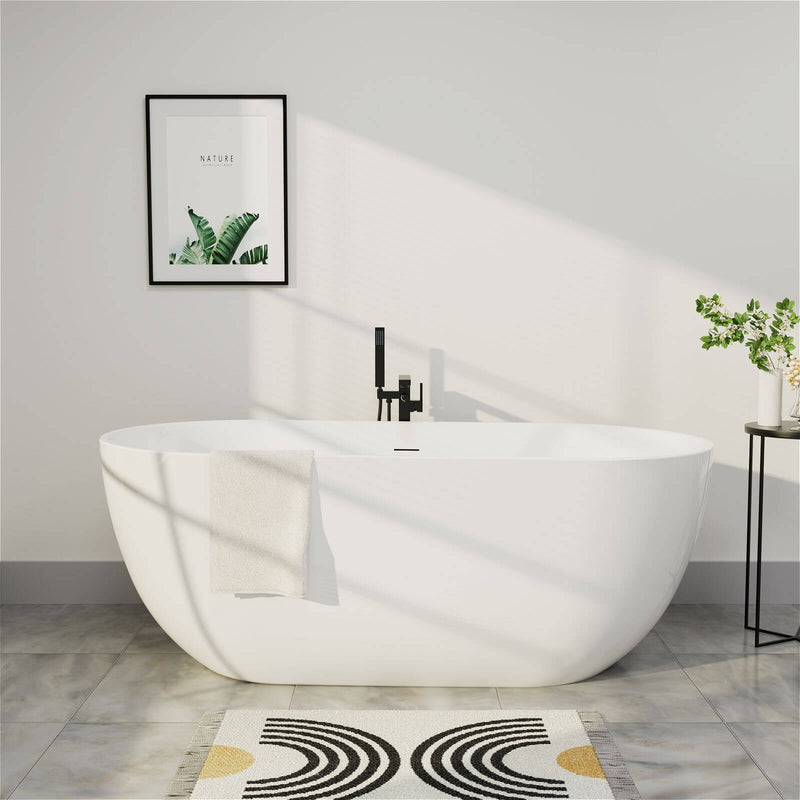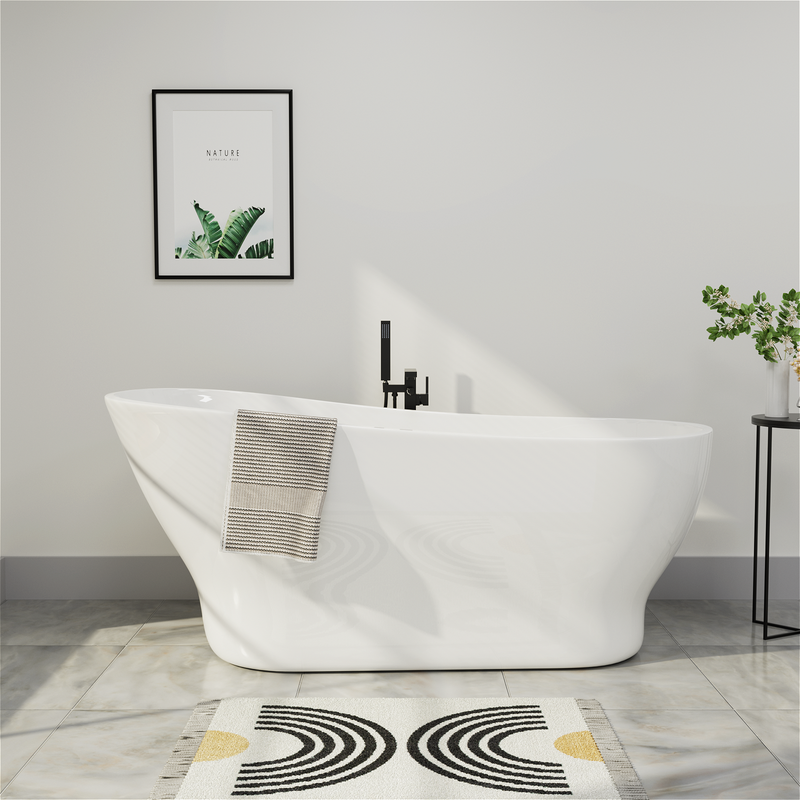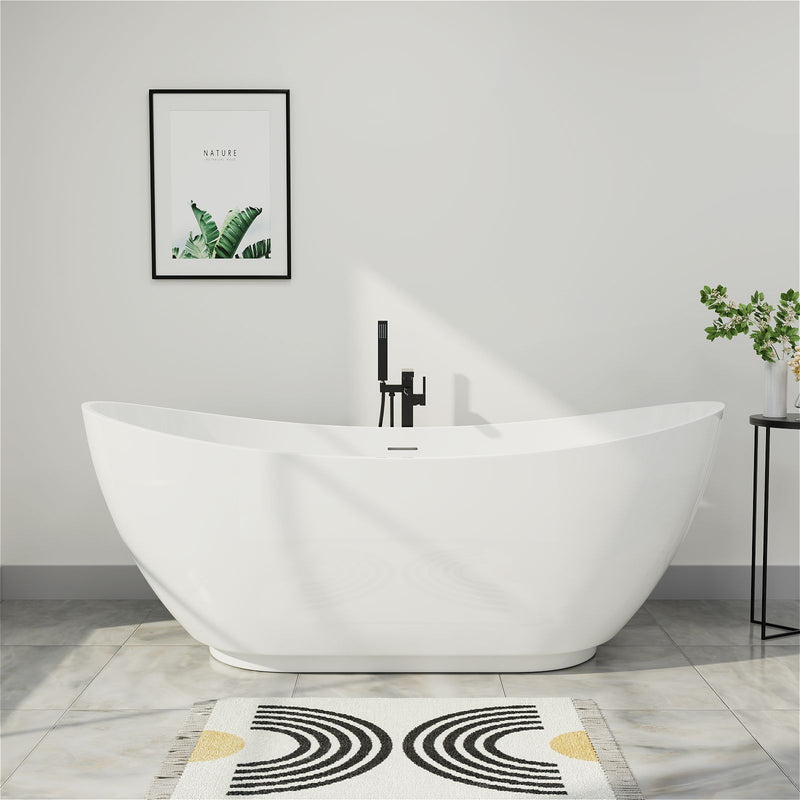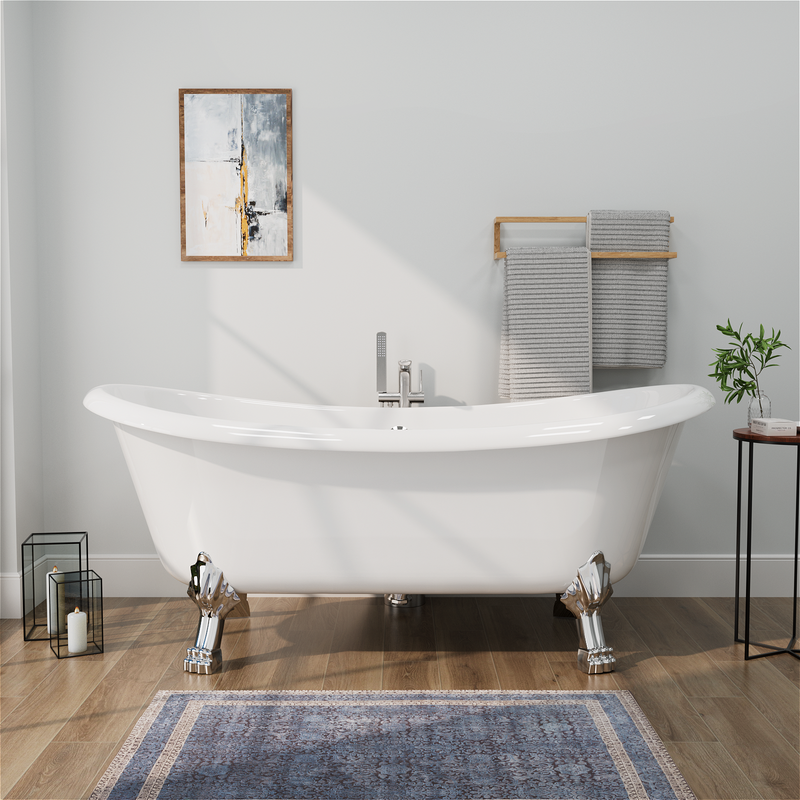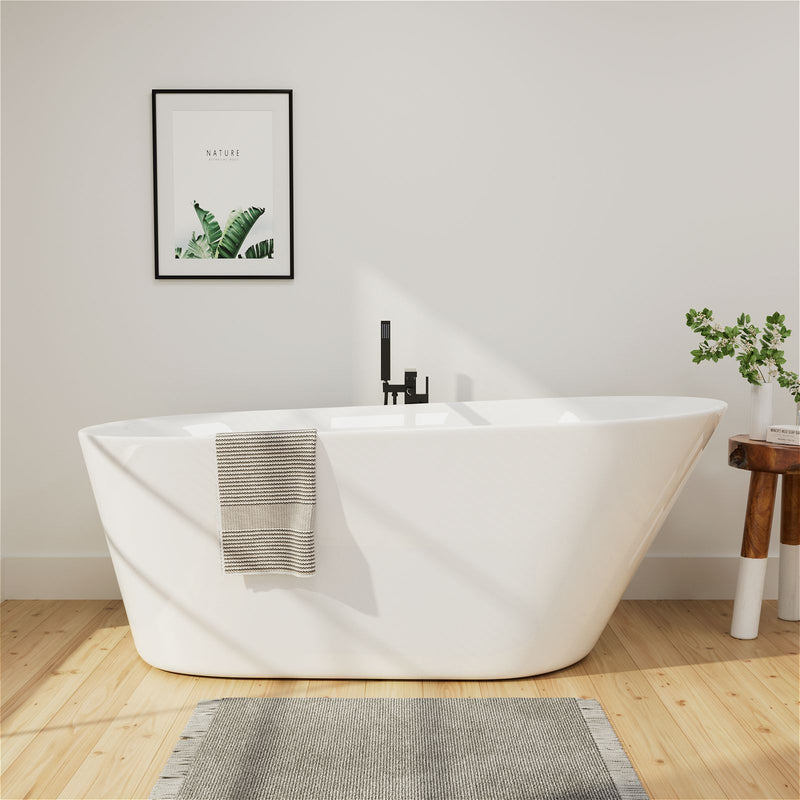In the world of bathroom design, certain types of bathtubs stand out not just for utility but for aesthetic presence and comfort. The double slipper bathtub is one such design — elegant, balanced, and often viewed as a centerpiece in a luxury bathroom. Unlike a traditional tub with one sloped end, a double slipper has raised ends on both sides, offering a symmetrical form and allowing two users to recline comfortably face-to-face or back-to-back. This combination of form and function makes it especially appealing for homeowners who value both style and experience.
What Is a Double Slipper Bathtub?
A slipper bathtub refers to a tub with one or two elevated (sloped) ends, designed to support the head, neck, and back in a reclining position. A double slipper bathtub raises both ends, giving it a symmetrical profile. This means the tub does not have a distinct back end and can be used from either side. (A modern freestanding double slipper tub often features this design.)
Some of the hallmark features include:
- Raised backrests at both ends, allowing a user to lean back comfortably whether they enter from either side.
- Freestanding or partly freestanding design, meaning the tub is not entirely enclosed by walls.
- A centrally located drain or a drain placed in a neutral position (not biased toward one end) in many designs to maintain symmetry.
- Deep bathing depth (more water coverage) in many models, especially those marketed as soaking tubs.
- Because of its symmetrical, open design, the double slipper bathtub is often chosen not only for its comfort but as a visual anchor in upscale bathroom layouts.
Why is it Called Slipper?
The term slipper comes from older bathtub styles in which the raised end resembled the sloping curve of a slipper (shoe). In early bathroom design, one end was elevated to provide a more comfortable leaning surface. Over time, designers adapted the concept to double-ended or double-sloped versions to support two ends.
Thus, the double slipper embodies both functional heritage and modern usability.
Benefits and Appeal of Double Slipper Bathtubs
Comfort and Ergonomics
One of the strongest selling points is the ability to recline comfortably from either end. With two sloped ends, the bathtub supports head, neck, and back without forcing you into a stiff posture. This ergonomic design reduces strain, allowing for a more relaxed soak.
If two people wish to bathe together, each can recline comfortably at opposite ends without turning around or facing one another in a cramped way. This mutual comfort is a key advantage in designs meant for couples.
Moreover, the central area between the sloped ends is often deeper or more spacious than in single-sloped tubs, allowing better immersion of the torso and legs.
Aesthetic and Design Impact
Visually, a double slipper tub brings balance and symmetry to a bathroom. Because both ends mirror each other, the tub reads as a sculptural element rather than a utilitarian fixture. In many design galleries, the tub becomes the focal point — framed by lighting, tile work, or window views.
Because it's often freestanding (or semi-freestanding), you can place it away from walls, in the center of a room, or in a position that maximizes visual flow. The open space around the tub allows light and furniture to interact with it, enhancing the sense of spaciousness.
Also, the symmetry helps avoid awkward plumbing or fixture placement bias toward one side; accessories and faucets can be designed to complement both ends.
Flexibility and Two-Person Use
Unlike single-ended tubs, the double slipper design inherently accommodates two bathers in a comfortable way. This doesn't mean every double slipper tub is made for tandem use, but many are sized to permit two people to soak without discomfort.
Even when used solo, the user can choose which end to recline against, offering flexibility in posture and bathing position. This is particularly useful for households where height differences or personal preferences vary.
Deeper Soaking Experience
Many double slipper tubs are designed with deeper interiors compatible with soaking style use. Because there is no need to limit depth to favor one end (as in single-sloped tubs), designers sometimes push depth higher, allowing more of the bather's body to be submerged.
Deeper water also promotes better heat retention and a more immersive relaxation. That said, careful attention must be paid to water volume, heating capacity, and structural support (weight) with such depth.
Increased Home Appeal and Luxury Feel
In many remodel reports and design studies, features that evoke a spa-like or luxury aesthetic boost perceived value. A double slipper bathtub often signals premium design, which may be attractive to buyers. Because it's less common than standard tubs, it stands out as a design statement.
When used carefully (in proportion, with high-quality materials, proper plumbing, and support), it can elevate a bath from a functional fixture to a lifestyle feature.
Design, Material & Practical Considerations
To realize the benefits listed above, you must navigate various design, structural, and material challenges. Here are key areas you should examine:
Size, Proportion & Layout
Double slipper tubs tend to be larger and sometimes wider than single-ended tubs. You'll need to ensure:
- Enough clearance around the tub for access and cleaning (often at least 4–6 inches on sides).
- Proper room dimensions so the tub doesn't dominate or feel too cramped.
- That doors, windows, and fixtures don't interfere with the tub's placement.
- That plumbing access is feasible—some double slipper tubs have central drains or need floor drains relocated.
If your bathroom is not expansive, a too-large double slipper tub may crowd other elements. Always measure and mock-up the layout before final installation.
Weight, Structural Support & Water Volume
Because these tubs can be deeper and hold more water, their combined weight (tub + water + occupants) can be significant. You'll need to:
- Calculate the full load, e.g., gallons of water × 8.34 lb/gallon, plus tub weight and people load.
- Confirm your floor framing (joists, subfloor) can support that load; you may need reinforcement or load-bearing modifications.
- Use materials that balance weight and strength. Some modern materials (e.g. composite, stone resin) offer strength with less weight than solid stone or cast iron.
Failure in structural support can lead to sagging, leaks, or long-term damage.
Material & Finish Options
Your choice of material has direct effects on heat retention, durability, maintenance, cost, and weight. Common materials include:
- Acrylic: Lightweight, easier to handle and install. Less heat retention compared to heavier materials but acceptable for many use cases.
- Composite / Solid Surface / Stone Resin: Offers better thermal performance, more rigidity, and a premium feel.
- Cast Iron / Enameled Steel: Classic, durable, and good at holding heat—but very heavy and demanding for floor support.
- Natural Stone (less common): Luxurious and heavy; demands robust support and careful installation.
Finishes should be scratch- and stain-resistant. Some manufacturers offer reinforced surfaces, anti-slip textures, or seamless coatings to enhance durability.
Drain, Overflow & Plumbing Considerations
The plumbing setup in a double slipper tub must maintain symmetry and function:
- Choosing drain placement (center or offset) that complements both ends without bias.
Ensuring the overflow system works properly regardless of which side is used. - Providing access for maintenance under or behind; freestanding plumbing lines may be exposed and need to be visually integrated.
- Verifying your water supply and heater can fill the tub to desired depth in a reasonable time.
- Considering trap primers or clean-out access, since deeper tubs may conceal plumbing behind panels.
Access, Entry & Safety
Because slipper tubs often have raised rims, entry and exit can be a challenge:
- Use grab bars or support rails near the tub rim.
- Consider low-threshold or step designs to ease access.
- Slip-resistant surfaces inside the tub help reduce falls or slips.
If children, elderly, or mobility-limited people will use the tub, plan for safety features accordingly.
Maintenance & Longevity
Frequent cleaning with nonabrasive, manufacturer-recommended cleaners helps preserve finish.
- Avoid harsh chemicals that degrade surfaces or seals.
- Inspect seals (drain, overflow, gaskets) regularly.
- Minor scratches or wear may be refinished or repaired depending on material.
Maintain access to plumbing for repairs, avoid fully sealing panels in inaccessible ways.
Challenges & Common Pitfalls
While double slipper tubs offer many advantages, buyers and installers often face challenges:
- Space constraints: In smaller bathrooms, a double slipper may overwhelm the room or make other fixtures cramped.
- Structural support issues: Underestimating the weight load can lead to floor sagging or failure.
- Cost: These tubs (especially in premium materials) plus plumbing, reinforcement, and labor can be substantially more expensive than standard tubs.
- Plumbing complexity: Center drains, overflow symmetry, or freestanding plumbing often require more precise plumbing work.
- Access for maintenance: Fully wall-enclosed installations may make servicing plumbing difficult.
- Entry/egress difficulty: Raised rims, slippery surfaces, and lack of integrated steps can be a safety concern.
- Water and heat capacity limits: If your water heater or plumbing is undersized, filling a large deep tub may take too long or leave water lukewarm.
- Mismatch of proportions: A too-narrow or too-short double slipper defeats the ergonomic potential. Always test user posture during showroom visits when possible.
Understanding these pitfalls early in planning helps avoid unpleasant surprises later.
How to Choose the Right Double Slipper Bathtub
Below is a practical decision roadmap to help homeowners select a double slipper tub fitting their space, style, and needs:
- Define your priorities: Is your emphasis on aesthetics, comfort, two-person use, deep soaking, or ease of maintenance?
- Measure your space: Sketch your bathroom layout, including clearances and walk paths. Make sure your chosen tub doesn't block doors or circulation.
- Load calculation: Estimate the total filled weight (tub + water + occupants) and check existing floor support or plan reinforcement.
- Material selection: Balance weight, heat retention, cost, and durability. Consider composite or solid-surface if weight is a concern.
- Drain & plumbing layout: Match the drain/overflow plan to your house plumbing. Consider how serviceable the installation will be.
- Test ergonomics: If possible, sit or recline in a showroom model. Check your head/neck position relative to the slope and rim.
- Safety features: Plan for grab bars, anti-slip surfaces, and access for users of different mobility levels.
- Finish, style & accessories: Choose finishes, faucet styles, and accessories (e.g. trays, pillows) that harmonize with your bathroom design.
- Professional installation & warranty: Always work with experienced plumbers and installers. Ensure the manufacturer's warranty isn't voided by installation mistakes.
- Long-term maintenance planning: Confirm access to parts, ability to resurface or refinish, and ease of plumbing access for repairs.
If you follow this roadmap and evaluate trade-offs, you'll be better positioned to get a double slipper tub that delivers both visual impact and everyday practicality.
FAQs
Q1: Is a double slipper bathtub always freestanding?
A: Not always, but many are. Freestanding means the tub is not fully enclosed by walls on all sides and often has exposed sides. Many double slipper tub designs embrace freestanding style to maximize their visual appeal and symmetry.
Q2: Can two people comfortably use a double slipper tub at the same time?
A: Yes, that's one of its advantages — if sized appropriately and designed with sufficient interior width and depth. Each person can recline at opposite ends without interference. However, not every double slipper tub is built for two people; always check internal dimensions and user comfort.
Q3: What is the typical size range for double slipper bathtubs?
A: Sizes vary widely. Some double slipper tubs length might range from around 66 to 72+ inches, widths from 30 to 36+ inches or more. Depth also varies depending on soaking design. Manufacturers often list interior dimensions and water capacity to help you evaluate.
Q4: Do double slipper tubs require more water and heating capacity?
A: Usually yes, because deeper filling volumes and larger internal space mean more gallons of water. This demands more from your water heater and may require more time to fill. Plan accordingly so your tankless heater or hot water system can keep up.
Q5: What materials are best for double slipper tubs?
A: There is no single best material — trade-offs matter.
- Acrylic: lighter and easier to install, but less heat retention.
- Composite / solid-surface: good balance of thermal performance and manageable weight.
- Cast iron / enameled steel: excellent for heat retention and durability but heavy.
- Natural stone: luxurious but extremely heavy and expensive.
Always consider weight, heat retention, maintenance, and your floor's load-bearing capacity.
Q6: What challenges should I expect during installation?
A: Some common challenges include: delivering the tub to the bathroom (narrow stairways, tight doors), reinforcing the subfloor, plumbing alignment (especially for central drains), ensuring level placement, and sealing around the base while preserving service access.
Q7: How do I maintain a double slipper bathtub for years?
A: Key maintenance steps: clean regularly with nonabrasive cleaners; inspect and reseal drain, overflow, and gaskets periodically; avoid harsh chemical cleaners; maintain access to plumbing; repair scratches or wear promptly using manufacturer-approved methods.
Q8: Will a double slipper tub add value to my home?
A: It can. Because it is perceived as a premium, spa-like fixture, a well-executed installation may improve appeal and perceived luxury. However, value depends heavily on quality of installation, compatibility with the home design, and how well it's integrated with plumbing and structure.
Conclusion
The double slipper bathtub is a compelling option for homeowners who value both comfort and visual elegance. Its dual-ended design offers ergonomic flexibility, allows two people to recline comfortably, and serves as a striking focal point in bathroom design. But to realize its potential, you must thoughtfully navigate size, materials, weight, plumbing, and access considerations.
By understanding the trade-offs, working with skilled professionals, and selecting a model that matches your space and preferences, you can turn your bathtub into more than a utility—it becomes a nightly retreat, a design statement, and a lasting asset for your home.

